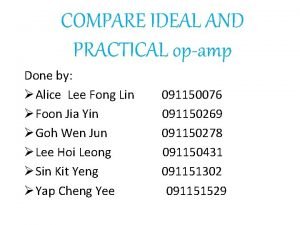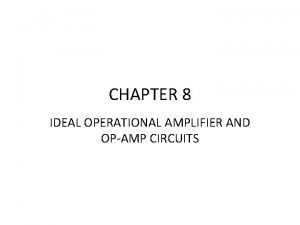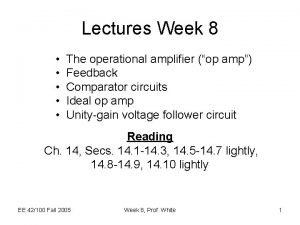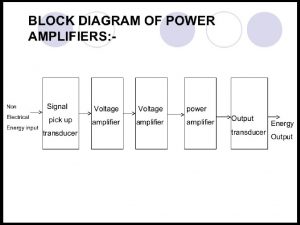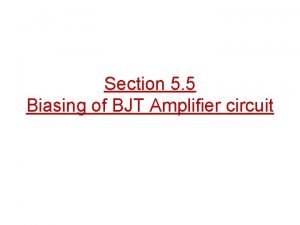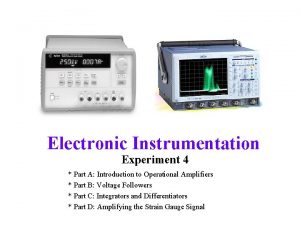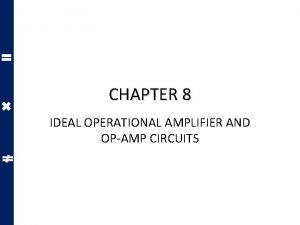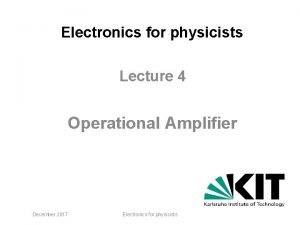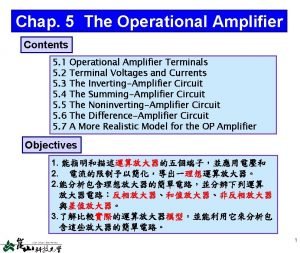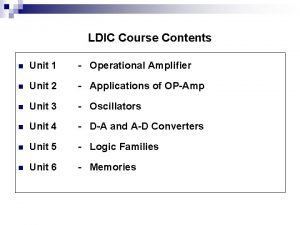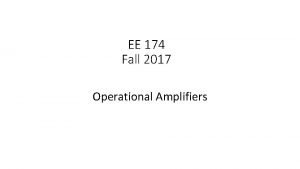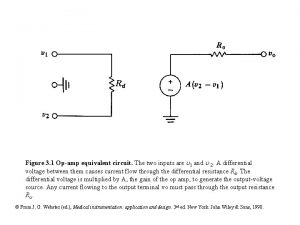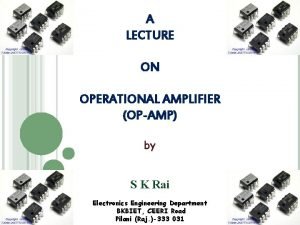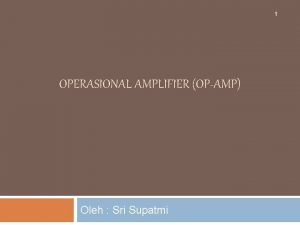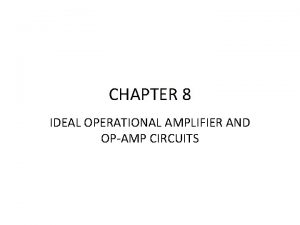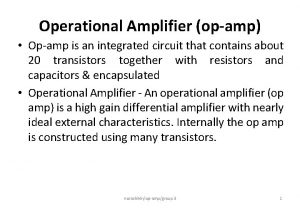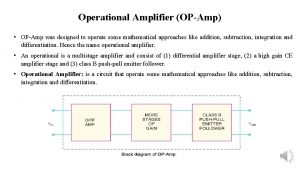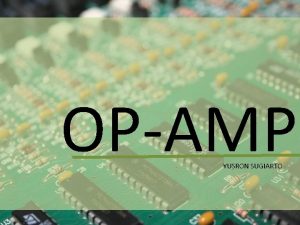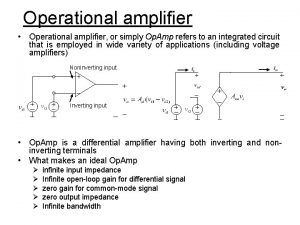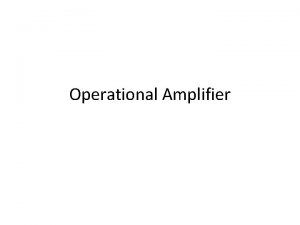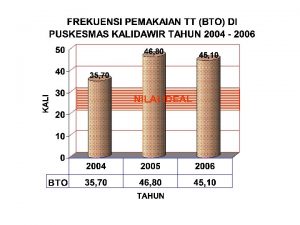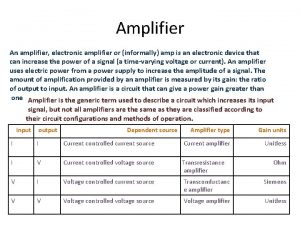IDEAL OPERATIONAL AMPLIFIER AND OPAMP CIRCUITS Control Systems



















- Slides: 19

IDEAL OPERATIONAL AMPLIFIER AND OP-AMP CIRCUITS Control Systems Components Third Year – Electrical Dep – Faculty of Engineering Prepared by Dr. Abdel Gayed Fathy

inverting output non-inverting Op-amp circuit symbol • Open loop mode • Vo = Aod ( v 2 – v 1) – Aod is referred to as the open loop gain. – Notice that is v 2 = v 1, the open loop gain equals to

An ideal op-amp, was measured in a lab experiment in open-loop mode. Determine the open loop gain (Aod) and complete the table below which shows the results of the experiment. V 1 (1) -1 m. V -0. 5 V 0. 99 V V 2 (2) +1 m. V -0. 506 V 1 V Vo (3) 1 V -3 V 5 V

• Op amp can be configured to be used for different type of circuit applications: – Inverting Amplifier – Non – inverting Amplifier – Summing Amplifier – Integrator – Differentiator

• Two main characteristics: • We want the open loop gain to be equal to which means that v 2 = v 1 0 0 • We also want the input resistance to be equal to , hence there is no current going into the op-amp

Inverting Amplifier Op-amp as an inverting amplifier Voltage at node 1 (inverting) = voltage at node 2 (non-inverting ) KCL at node 1: (Vi – 0) / R 1 = (0 – Vo) / R 2 Vi / R 1 = - V o / R 2 Vo = - R 2 Vi R 1

Exercise Gain = - (R 2 / R 1) = -(150/12) = -12. 5

Can the voltage gain be calculated using the same formula? Try and use the same method in deriving Vo/Vi

Non - Inverting Amplifier Voltage at node 1 (inverting) = voltage at node 2 (non-inverting ) KCL at node 1: (0– Vi) / R 1 = (Vi – Vo) / R 2 -(Vi / R 1) = (Vi / R 2) – (Vo / R 2) Vo / R 2 = (Vi / R 2) + (Vi / R 1) = Vi 1 + 1 R 2 Vo / V i = R 2 1 + 1 R 2 R 1 Noninverting amplifier

Voltage Follower / Buffer Amplifier Vo = V i Hence, gain = 1

Summing Amplifier Similarly, i 1 + i 2 + i 3 – i 4 – 0 = 0 Example Design a summing amplifier as shown in figure to produce a specific output signal, such that vo = 1. 25 – 2. 5 cos t volt. Assume the input signals are v. I 1 = -1. 0 V, v. I 2 = 0. 5 cos t volt. Assume the feedback resistance RF = 10 k

Solution: output voltage

Other Op-Amp Applications

Integrator circuit

Differentiator EXAMPLE Differentiator circuit

Calculating Gain and Design Questions NON - INVERTING Calculating Output and Design Questions SUMMING AMPLIFIER DIFFERENTIATOR AMPLIFIER INTEGRATOR AMPLIFIER

Va NON - INVERTING Vb INVERTING Calculate the input voltage if the final output, VO is 10. 08 V. Finally: Va = (1 + 10/5) V 1 0. 504 = 3 V 1 = 0. 168 V Then: Vb = -(5/5) Va -0. 504 = - Va Va = 0. 504 V Have to work backwards: Vo = -(100/5) Vb 10. 08 = -20 Vb Vb = -0. 504 V

What is the value of Vin 1 from the figure above? 12 = - 24 [ Vin 1 / 24 + (-2) / 24 + (-6) / 24 ] 12 = - [ Vin 1 – 2 – 6 ] 12 = - Vin 1 + 2 + 6 Vin 1 = - 4 V

Va INVERTING SUMMING Calculate the output voltage, VO if V 1 = V 2 = 700 m. V Va = -(500/250) 0. 7 Va = -1. 4 V Then: Vo = - 500 [ Va / 100 + V 2 / 50 ] Vo = - 500 [ -1. 4 / 100 + 0. 7 / 50 ] Vo = 0 V
 Compare ideal op-amp and practical op-amp
Compare ideal op-amp and practical op-amp Ideal opamp
Ideal opamp Operational amplifier invented
Operational amplifier invented What's inside an op amp
What's inside an op amp Difference between power and voltage amplifier
Difference between power and voltage amplifier Transistor amplifier biasing
Transistor amplifier biasing Conclusion operational amplifier
Conclusion operational amplifier Penguat operasional
Penguat operasional Operational amplifier experiment
Operational amplifier experiment Operational amplifier inverter
Operational amplifier inverter Operational amplifier
Operational amplifier Summing circuit
Summing circuit Op amp open loop configuration
Op amp open loop configuration History of op amp
History of op amp Operational amplifier is also called as
Operational amplifier is also called as Advantages of parallel circuit over series circuit
Advantages of parallel circuit over series circuit Opamp equivalent circuit
Opamp equivalent circuit Op amp sembolü
Op amp sembolü Virtual ground concept
Virtual ground concept Rumus vout op amp
Rumus vout op amp
